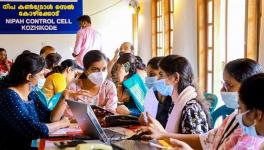India Tops List of Nations in Highest Stillbirths Caused by air Pollution

Representational use only.Image Courtesy: Flickr
India tops the world in the number of stillbirths caused by air pollution, specifically due to particulate matter (PM)2.5, recent research published in Nature Communication reveals. The study estimated the number of stillbirths caused by exposure to PM2.5 in 137 countries during 2000-2019.
India’s situation is worrisome, according to the study, with 2,17,000 stillbirths caused by PM2.5 in the study period. South Asia, sub-Saharan Africa and Arabian deserts have been the hotspots of such stillbirths. Following India, Pakistan (with 1,10,000 cases), Nigeria (93,000), China (64,000) and Bangladesh (49,000) are at the top of the list.
The study also found that countries with the highest fraction of stillbirths that are related to the exposure of PM2.5 include Qatar (71%), Saudi Arabia (68%) Kuwait (66%), Niger (65.6%) and the UAE (64.6%).
Among different components of air pollutants, PM is of increasing concern across the world. These inhalable fine particles are tiny and also reduce visibility due to the haze caused by their elevated levels. PM2.5 has a diameter of 2.5 micrometres. These tiny pollutants can be released into the atmosphere from a variety of sources, including construction sites, unpaved roads or even fires. However, most of the particles are formed in the atmosphere from complex reactions involving chemicals such as sulphur dioxide and nitrogen oxides, emitted from various sources like power plants, vehicles and industries.
The high exposure to PM2.5 during the gestation period contributes to one-fourth of stillbirths. The study represents a comprehensive global risk assessment of PM2.5-related stillbirths and covers 137 countries in Asia, Africa and Latin America. Importantly, these are the regions that constitute 98% of stillbirths globally.
The study analysed 13,879 stillbirths and 32,449 live births from various global surveys. Each of the live births was compared to stillbirths of the same mother by applying statistical tools. It was found that with an increase of 10 microgrammes of PM2.5, the risk of stillbirths increases by 11%. This increased risk was also found to be associated significantly with maternal age.
In 2015, out of the 2.09 million stillbirths, 0.83 million, or nearly 40% of cases, were attributable to PM2.5 exposure. It suggests that preventing pregnant women from getting exposed to PM2.5 can improve maternal health in low- and middle-income countries (LMICs).
Stillbirth is the death or loss of a baby that happens before or during delivery. The terms ‘stillbirth’ and ‘miscarriage’ both refer to the loss of a baby but differ in terms of the time when the loss occurs. According to the World Health Organization (WHO), a baby that dies after 28 weeks of pregnancy, before or during birth, is termed a stillbirth. Whereas in the US, the definition is slightly different—when a baby dies at or after 20 weeks of pregnancy and if it happens before 20 weeks then it is called a miscarriage.
Notably, the UN has termed the global burden of stillbirths a neglected tragedy. According to the UNIGME (United Nations Inter-Agency Groups for Child Mortality Estimation), 2 million stillbirths were reported globally in 2019 with stillbirth prevention progress slowing down, especially in LMICs.
Get the latest reports & analysis with people's perspective on Protests, movements & deep analytical videos, discussions of the current affairs in your Telegram app. Subscribe to NewsClick's Telegram channel & get Real-Time updates on stories, as they get published on our website.
























